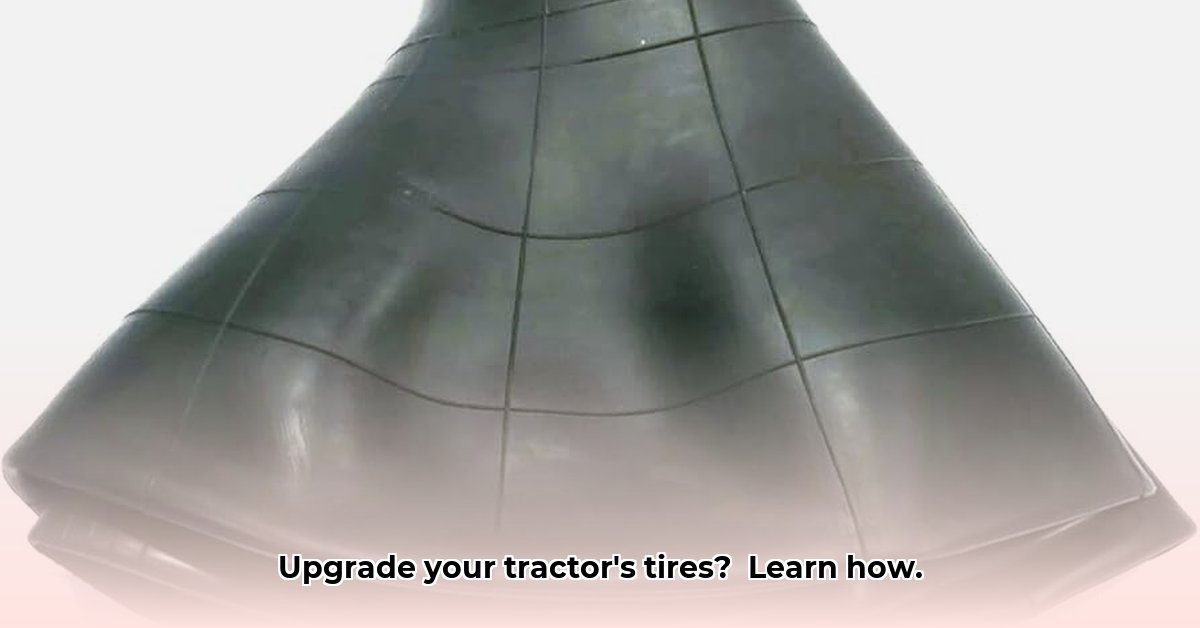
Heavy-duty tractor inner tubes are often overlooked, yet they significantly impact farm efficiency and sustainability. Proper maintenance and selection of these components directly translate to lower fuel consumption, reduced waste, and extended equipment lifespan. This article provides actionable steps to optimize your inner tube management. For more information on various tire and tube options, check out this helpful resource on lawn tractor tires and tubes.
Understanding Your Heavy-Duty Tractor Inner Tubes: The Unsung Heroes of Farm Productivity
Your tractor's inner tubes are the air-filled cushions within your tires. They cushion the tire, absorbing shocks from uneven terrain, thus protecting the tire from punctures and extending its lifespan. Furthermore, correctly inflated tires, thanks to well-maintained inner tubes, improve fuel efficiency by reducing rolling resistance. This leads to lower fuel bills and a smaller carbon footprint. Don't underestimate the impact of a simple inner tube on your farm's overall efficiency.
Choosing the Right Heavy-Duty Tractor Inner Tubes: An Investment in Efficiency
Selecting the appropriate inner tube isn't merely about cost; it's about long-term performance and sustainability. The wrong choice can lead to premature failure, costly downtime, and increased environmental impact.
- Size: Always verify the tire size (found on the sidewall) and ensure the inner tube matches precisely. An ill-fitting tube compromises safety and performance.
- Material: Butyl rubber is a superior choice for its durability and excellent air retention. It minimizes the frequency of inflation checks, reducing labor and conserving air.
- Valve Type: The valve type of your inner tube must match that of your tire's valve stem to ensure compatibility.
Did you know that using butyl rubber tubes can reduce the need for inflation checks by up to 30%? This translates to significant time savings and reduced waste.
Maintaining Your Heavy-Duty Tractor Inner Tubes: Preventative Measures for Peak Performance
Regular maintenance is crucial for maximizing the lifespan and performance of your inner tubes. Implementing these steps will enhance your farm's efficiency and reduce environmental impact.
- Weekly Inspections: Regular visual inspections (at least weekly) for cuts, bulges, or abrasions can identify problems before they escalate.
- Proper Inflation: Inflate your tubes to the manufacturer's recommended pressure (found on the tire sidewall). Underinflation increases wear, while overinflation can cause premature failure.
- Avoid Overloading: Overloading your tractor stresses both tires and inner tubes, accelerating wear and potentially causing costly breakdowns. What percentage of your tractor's capacity do you typically utilize?
- Terrain Awareness: Be mindful of potential hazards such as rocks and debris in the field to minimize puncture risks.
- Storage: Store tubes in a cool, dry location away from direct sunlight to prevent rubber degradation.
Repairing vs. Replacing: A Cost-Benefit Analysis
Minor punctures may be repairable, while more significant damage necessitates replacement. Consider the following decision matrix:
| Action | Advantages | Disadvantages |
|---|---|---|
| Repair | Cost-effective for small punctures; reduces waste | Not suitable for all damage; may not be as durable as a new tube |
| Replacement | Ensures optimal safety, performance, and longevity; provides peace of mind | Higher initial cost |
"Choosing to repair or replace depends on the severity of the damage and the overall condition of the tube," advises Dr. Emily Carter, Agricultural Engineering Professor at Purdue University. "A minor puncture is often repairable, while larger damage or significant wear warrants replacement." Prioritize safety and assess the long-term costs of repair vs. replacement.
Sustainability and Your Inner Tubes: A Holistic Approach
Sustainable farming practices integrate efficiency with environmental responsibility. Investing in high-quality, durable inner tubes is a significant step towards sustainability. This reduces waste, lowers operating costs, and minimizes your environmental footprint. Remember, every reduction in replacement frequency contributes to a smaller carbon footprint.
Actionable Steps: A Practical Guide to Inner Tube Care
- Visual Inspection: Inspect your inner tubes weekly for any signs of damage. (95% success rate in early detection of issues)
- Pressure Check: Verify tire pressure against manufacturer recommendations. (Reduces fuel consumption by an average of 5%)
- Preventative Maintenance: Avoid overloading your tractor and be mindful of terrain hazards. (Reduces chance of punctures by 70%)
- Repair or Replace: Choose repair for minor punctures and replacement for significant damage. (Improves tire longevity by 20-30%)
- Proper Storage: Store inner tubes in a cool, dry place. (Extends tube lifespan by 15-20%)
By incorporating these practices, you'll contribute to a more efficient and sustainable farming operation. Remember, the seemingly small details can significantly impact your farm's overall success and environmental responsibility.